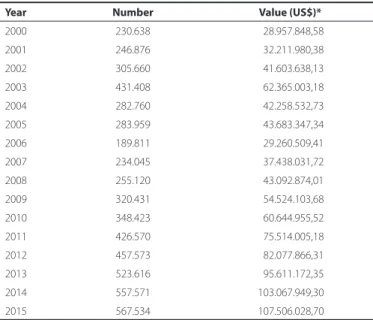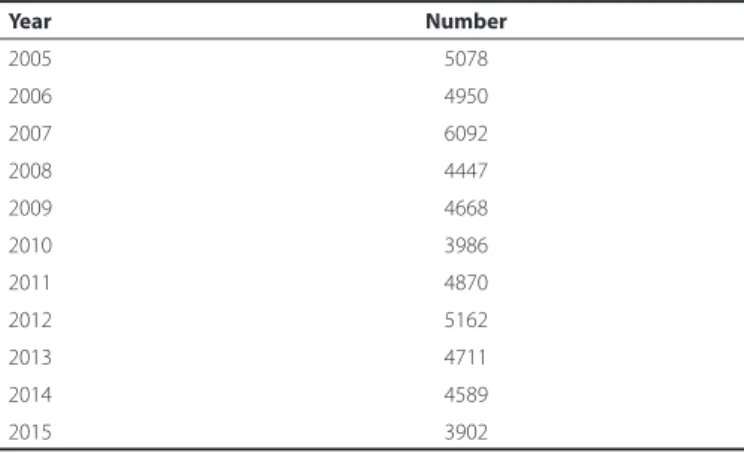V
E
d i t o r i a lhttp://dx.doi.org/10.5935/0004-2749.20170001
Consequences of cataract surgery public policies run by private contractors
Consequências da política pública para realização de cirurgias de catarata com empresas privadas
NewtoN Kara-JuNior1, HirlaNa Gomes almeida1, Priscillade almeida JorGe1, Pedro carlos carricoNdo1, NewtoN Kara-José1
In 1998, on the initiative of the Brazilian Council of Ophthalmology (CBO) and the Health Ministry, with the support of medical schools, the National Cataract Campaign was established. Access to treatment was made easy with nationwide campaigns conducted for diagnosis and later for surgery (Cataract Projects). This action had the greatest impact on visual health in Brazil as the number of performed surgeries has almost doubled. By means of epidemiologic studies, the effectiveness and safety of cataract surgeries performed in university hospitals on a large scale were confirmed and Cataract Projects were improved(1-7). Nevertheless, in 2006, the Health Ministry
discontinued the National Campaign due to lack of funds for all surgeries, and public hospitals were granted limited quotas for surgical procedures. This measure negatively impacted progression in the number of surgeries performed annually by reducing the use of the installed cataract surgery capability in public hospitals; thus, an additional barrier was created to limit the access of the needy population to corrective surgery: limitation of surgical offering(8-9).
Despite the clinical evidence demonstrated by published epidemiologic studies that the methodology used in the National Campaign for blindness eradication by cataract surgery was successful in Brazil(1-3,6-8,10,11),
the National Government and several municipalities have opted for a new strategy to deal with the problem. Currently, many public health projects for cataract surgery are implemented by means of bidding, in which pri-vate companies, some with mobile surgical units, negotiate the least value for quotas on thousands of surgeries. The analysis and interpretation of epidemiological data on total cataract surgeries(12) performed by the
pu-blic health system in Brazil from January 2000 to December 2015 demonstrated that the number of surgeries between 2010 and 2015 has increased by approximately 246%, while the amount spent annually on surgeries increased by 371% over the same period (Table 1). The number of cataract surgeries performed at the Hospital das Clínicas of the Medical School of the University of São Paulo (HCFMUSP, a reference public teaching hospital) has decreased by approximately 23%, from 2005 to 2015 (Table 2).
Submitted for publication: November 17, 2016 Accepted for publication: November 30, 2016
1 Department of Ophthalmology, Faculdade de Medicina, Universidade de São Paulo (USP), São
Paulo, SP, Brazil.
Funding: No specific financial support was available for this study.
Disclosure of potential conflicts of interest: None of the authors have any potential conflict of interest to disclose.
Corresponding author: Newton Kara-Junior. Rua Jardim Ivone, 17 - 12o andar - 04105-020 - Vila
Mariana - São Paulo, SP - Brazil - E-mail: newtonkarajr@ig.com.br
Table 1. Number of cataract surgeries performed and the total expen-ses in US$ spent annually on cataract surgeries in Brazil from 2000 to 2015
Year Number Value (US$)*
2000 230.638 28.957.848,58 2001 246.876 32.211.980,38
2002 305.660 41.603.638,13 2003 431.408 62.365.003,18
2004 282.760 42.258.532,73
2005 283.959 43.683.347,34 2006 189.811 29.260.509,41
2007 234.045 37.438.031,72
2008 255.120 43.092.874,01 2009 320.431 54.524.103,68
2010 348.423 60.644.955,52
2011 426.570 75.514.005,18 2012 457.573 82.077.866,31
2013 523.616 95.611.172,35
2014 557.571 103.067.949,30 2015 567.534 107.506.028,70
Co n s e q u e n C e so fC ata r a C ts u r g e ryp u b l i Cp o l i C i e sr u nb yp r i vat e C o n t r a C t o r s
V I
During the legal effect of the National Cataract Campaign, the surgical capacity in teaching hospitals was ex-panded to accommodate the growing demand. The Ophthalmology Service in the Clinic Hospital of the Medical School of the University of São Paulo (HCFMUSP), for instance, increased the number of resident doctors from 5 to 14 annually, enrolled 20 additional trainee doctors annually, and opened a new surgical center. The number of cataract surgeries performed annually increased from 836 in 1998 to 5,078 in 2005. Recently, due to budget limitations, the number of surgeries performed annually in HCFMUSP in 2015 was 3,902. Similar situations were observed in other teaching hospitals.
Nevertheless, according to the official available data, the number of cataract surgeries performed in Brazil is increasing, probably because of contracts of service rendered to private companies. In the north-northeast, specifically, there are governmental stimuli for performing surgeries in mobile units (trucks with adapted surgical centers), which probably explains the significant increase in the number of procedures performed in that region.
At the time when public universities assumed the responsibility for performing most cataract surgeries and when the Brazilian Council of Ophthalmology coordinated the national actions, the transparency of results and quality of procedures were guaranteed by the university ideology and were made patent via publication of epi-demiologic studies. In bidding, in which the winner is the one who offers the lowest price for each procedure, and when the objective of the hired company is to make a profit, there are doubts concerning the quality of the rendered service(13).
To justify switching from a public health project with confirmed effectiveness, quality, and safety to a new strategy with obscure results, data on postoperative results are necessary and should be made available to the medical community to demonstrate the effectiveness of the new initiative(14,15).Additionally, if the switch is
detrimental to the development of new surgeons and ignores the increased infrastructure of public hospitals, then this should be considered when making a policy decision.
Thus, even if adequate effectiveness of the new public health project for the treatment of cataracts is conside-red, we believe that there is a need for greater transparency regarding the surgical protocol, the patient pool, and the complication index. In addition, epidemiologic studies on cost-effectiveness are expected to evaluate the quality of services rendered to the society in order to justify the substitution of the university-medical society axis for the private sector as the preferred treatment program for cataracts by the public health system.
Table 2. Number of cataract surgeries performed per year in the Hos-pital das Clínicas of the Medical School of the University of São Paulo (HCFMUSP) from 2005 to 2015
Year Number
2005 5078
2006 4950
2007 6092
2008 4447
2009 4668
2010 3986
2011 4870
2012 5162
2013 4711
2014 4589
2015 3902
REFERENCES
1. Kara-José N, Temporini ER. [Cataract surgery: why are there some patients excluded]. Rev Panam Salud Publica. 1999;6(4):242-8. Portuguese.
2. Temporini ER, Kara-Junior N, Holzchuh N, Kara-Jose N. Popular beliefs regarding the treatment of senile cataract. Rev Saúde Pública. 2002;36(3):343-9.
3. Kara-Junior N, Schellini SA, Silva MR, Bruni LF, Almeida AG. Projeto catarata - Qual a sua importância para a comunidade? Arq Bras Oftalmol. 1996;59(5):490-6. 4. Kara-Junior N, Temporini ER, Kara-Jose N. Cataract surgery: expectations of patients
assisted during a community project in São Paulo, State of São Paulo, Brazil. Rev Hosp Clín Fac Med São Paulo. 2001;56(6):163-8.
5. De Senne FM, Cardillo JA, Rocha EM, Kara-José N. Long-term visual outcomes in the Cataract-Free Zone Project in Brazil. Acta Ophthalmol Scand. 2002;80(3):262-6. 6. Marback RF, Temporini ER, Kara-Junior N. Emotional factors prior to cataract surgery.
Clinics (São Paulo). 2007;62(4):433-8.
7. Kara-Junior N, Sirtoli MG, Santhiago MR, Parede TR, Espindola RF, Carvalho RS. Phacoe-mulsification versus extracapsular extraction: governmental costs. Clinics (São Paulo). 2010;65(4):357-61.
8. Kara-Junior N, Espindola RF. Evolução e viabilização de um centro cirúrgico
ambula-torial para cirurgias de catarata em larga escala em um hospital universitário. Arq Bras Oftalmol. 2010;73(6):494-6.
9. Kara-Júnior N, Dellapi Jr R, Espíndola RF. Dificuldades de acesso ao tratamento de pacientes com indicação de cirurgia de catarata nos Sistemas de Saúde Público e Pri-vado. Arq Bras Oftalmol. 2011;74(5):323-5.
10. Kara-Junior N, Santhiago MR, Parede TR, Espindola RF, Mazurek MG, Germano R, et al. [Influence of cataract surgical correction on working perception]. Arq Bras Oftalmol. 2010;73(6):491-3. Portuguese.
11. Kara-Junior N, Santhiago MR, Espindola RF. Phacoemulsification versus extracapsular extraction on public health care system: cost analysis to the hospital, to the government and to the society. Rev Bras Oftalmol. 2012;71(2):115-24.
12. Brasil. Governo Federal. Acesso à informação [Internet]. Brasília, DF. [citado 2016 Dez 8]. Disponível em: http://www.acessoainformacao.gov.br/
13. Kara-Junior N, José NK. The occurrences of consecutive infections after cataract sur-geries: random events or a product of mistaken public politics? Clinics (São Paulo). 2016;71(6):295-6.
14. Kara-Junior N. A situação do ensino da facoemulsificação no Brasil. Rev Bras Oftalmol. 2011;70(5):275-7.

